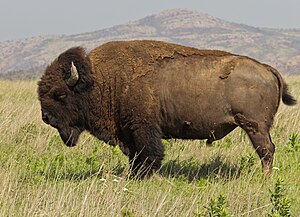Field Guide/Mammals/American Bison
< Field Guide | Mammals
| Bison Bison (American Bison) | |
|---|---|
|
Family: Bovine (Bovidae)
Size: The average length of an American Bison is 6.5-11.5ft(2-3.5m)long, the tail length is about 11.8-35.8in(30-91 cm) and it weighs between 701-2203lbs(318- 1,000 kg).
[1]
Description: The American Bison is a large hooved animal that spends most of its time grazing in the North American prairies. They have a sloping back and a massive head with two horns that curve upwards. Fur color can range from chestnut-brown to white (which is considered sacred in the Native American culture) in calves, to dark brown for adults.[1]
Similar Species: The American Bison can be distinguished from other bison by the fact that they have 15 ribs , while European bison have 14, they have four lumbar vertebrae (European has five), and the adult American bison are slightly heavier and have shorter legs. The American bison also has a nose that is set farther forward than European bison. It is also hairier, though the tail has less hair than that of the European bison. American Bison also graze more than the European bison. They drink water or consume snow on a daily basis.
Range: The American Bison’s range of population was once the grasslands of North American, but has since been restricted to a few national parks and reserves. Historically, their range was between the Great Bear Lake in Canada (far northwest) and the Mexican states of Durango and Nuevo Leon to the south. They were also known to stretch as far east as the Appalachian Mountains prior to their decline in population.[2]
Habitat: Historically the American Bison would favor large open prairies and grasslands. Presently, they are restricted within the confines of National parks that provide adequate grazing grounds. There tends to be trees, rivers, and valleys.
Diet: The American Bison is a herbivore that primarily grazes on grass and sedges.[3] They drink water water or consume snow on a daily basis.[4]
Activity: The American Bison is a migratory animal and have usual daily movements between foraging sites during the summer. Their daily schedule consists of two-hour periods of grazing, resting and cud chewing, then moving to a new location to graze. They can have been known to travel up to 2 miles(3.2 km) a day.[4] Their movement is also influenced by the seasonal vegetation changes, interspersion and size of foraging sites, and the number of biting insects. The availability of water may also be a factor. They also tend to gather in more wooded areas during the fall in winter, versus the open plains area they favor in the spring and summer.
Reproduction: The American Bison mate in late spring and summer, usually in August or September. The gestation period is 285 days. A single calf nurses until the next calf is born, and if the cow is not pregnant, a calf will nurse for 18 months.[1][4]
Lifespan: The American Bison has a life expectancy of about 15 years in the wild and up to 25 years in captivity.
Notes: The American Bison is often used in North America in official seals, flags, logos, and coins and is particularly popular in the Great Plains states. It has appeared as an official mascot for many sports teams, and is even the official state mammal of Kansas, Oklahoma, and Wyoming.
Despite its gentle-seeming nature, the American Bison are among the most dangerous animals encountered by visitors to the various U.S. and Canadian national parks and will attack humans if provoked. They appear slow because of their lethargic movements but can easily outrun humans, topping speeds of up to 40 miles per hour. Between 1980 and 1999, more than three times as many people in Yellowstone National Park were injured by bison than by bears, charging and injuring a total of 79 people and killing 1.[5] A proposal known as Buffalo Commons has been suggested by a handful of academics and policymakers to restore large parts of the drier portion of the Great Plains to native prairie grazed by bison. Arguments against this proposal include the notion that current agricultural use of the shortgrass prairie is not sustainable due to the periodic disasters it has sustained, one of which includes the Dust Bowl. Those that live in the area of question have also opposed the idea.[6] |
 |
- ↑ a b c
Newell, T.L.; Sorin, A.B. (2003), ADW: Bison bison., retrieved (October 13, 2012)
{{citation}}: Check date values in:|accessdate=(help) - ↑
Bison bison range map; American Bison., (1999), retrieved (October 13, 2012)
{{citation}}: Check date values in:|accessdate=and|year=(help) - ↑
Meagher, M., Historic Bison Study- Yellowstone National Park., retrieved (October 13, 2012)
{{citation}}: Check date values in:|accessdate=(help) - ↑ a b c
McHugh, Tom, Abstract - Social Behavior of the American Buffalo (Bison bison bison), retrieved (October 13, 2012)
{{citation}}: Check date values in:|accessdate=(help) - ↑
Caslick, J. (2011), Wildlife-Human Conflicts in Yellowstone. When Animals and People Get TooClose., retrieved (October 13, 2012)
{{citation}}: Check date values in:|accessdate=(help) - ↑
Great Plains Restoration Council, retrieved (October 13, 2012)
{{citation}}: Check date values in:|accessdate=(help)